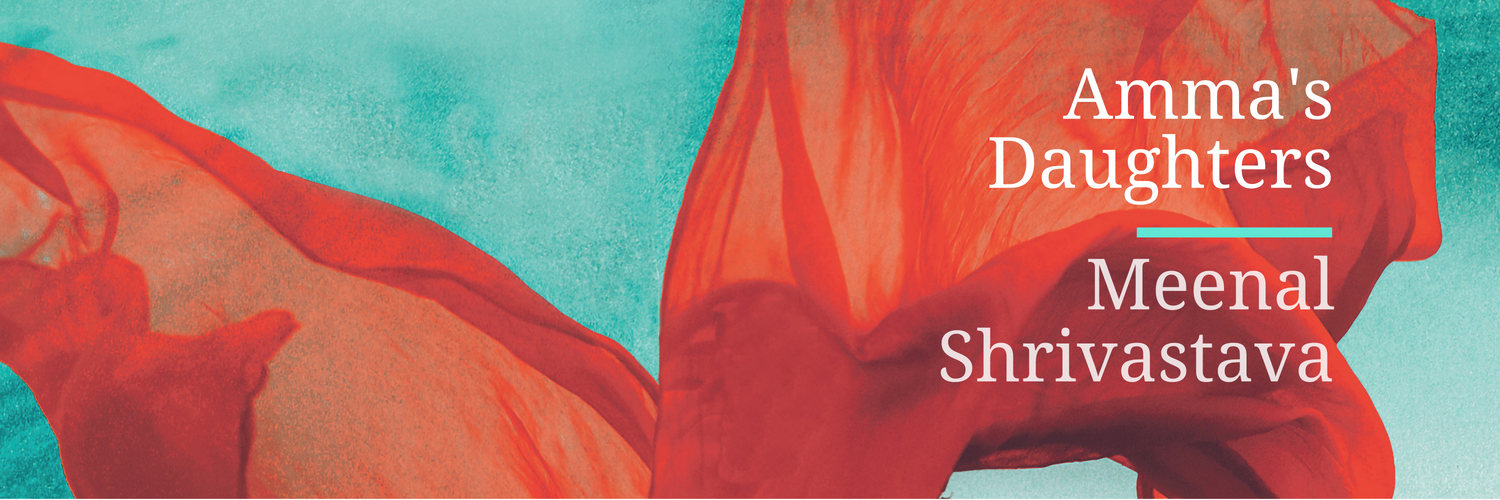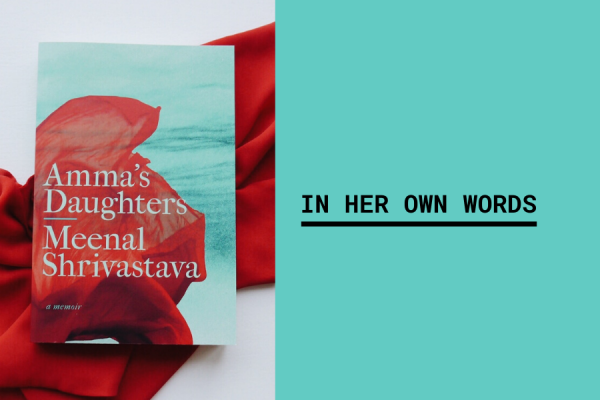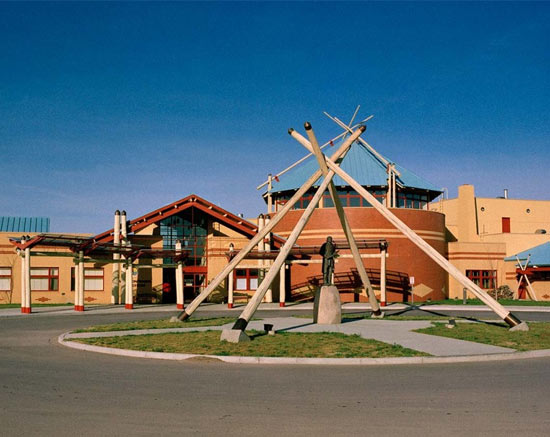We sat down with Meenal Shrivastava, professor of political economy and global studies and author of the newly released Amma’s Daughters: A Memoir. In this moving work of creative non-fiction, Shrivastava tells the story of her grandmother’s participation in India’s nationalist movement. Shrivastava writes from her mother’s perspective who, throughout her life, became the keeper of a history often untold: the story of how women relentlessly and selflessly sacrificed in support of India’s independence. Today, Shrivastava shares some details of her writing process and how she used the power of story to give voice to the women of India.
AUP: In your preface, you talk about story as a powerful tool that can “reclaim what standard histories have conspired to erase.” Amma’s Daughters tells the important story of women revolutionaries in India’s nationalist movement who have been largely forgotten. Can you tell us about the moment you realized something was missing from that time and how your family’s history fills that gap?
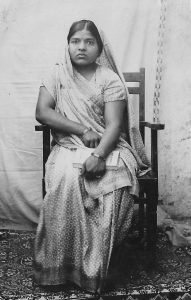
Amma, photographed in Wardha in 1941, around the time of her marriage to Babu. As so often, the faraway expression on her face is hard to read—a sober commitment to building a future, with a hint of past sorrows in her eyes.
MS: My mother had this project in mind for a long time. She grew up in her mother and her father’s shadow—as did I actually, a generation later growing up in Jaipur, we were always referred to as related to Prakashwati Sinha or Narayan Sinha, my maternal grandparents. They had this larger than life persona and my mother wanted to write about their work in the freedom movement, particularly about her mother’s role. I recognized that their lives were part of a larger story when I started doing the research.
My mother passed away in 2010 after battling cancer and I had made her this promise that we would write this book together. I couldn’t quite fulfill that promise once she was gone. But it was probably a way for me to cope with my own trauma of losing my mother at quite a young age—she was only 64 years old. I started doing research and collecting materials from the family archive and I also started supplementing my grandmother and mother’s diaries, my grandmother’s autobiography, and the photographic record with interviews from people who either had known my grandparents or had some sort of connection with them. I started doing archival research and secondary literature surveys to contextualize but also to authenticate the private records. It started as a personal project, but as I started digging into the archives in London, New Delhi, and Patna, and as I started looking at documents from that era, I realized that my grandmother had a unique life because of the age at which she left home and joined the freedom movement. As a twelve-year-old girl who was imprisoned for treason and sedition in 1930, she had a unique story.
At the same time, I had this dawning realization as I was going through all of these local newspapers and declassified reports from the British authorities that there were these hundreds of thousands of other women who participated in the political protests and the civil disobedience movement between 1930 and 1933. It was essentially the participation of a very large number of ordinary women that really made it into a mass movement. And to me it really striking because I was a student of modern Indian history and I felt like I understood the basic structure of the freedom movement and the social and political structures of this movement in India. Doing this archival research made me realize what a big blind spot still exists—that is, the role of these ordinary women.
AUP: That must have been an amazing moment of realization. Amma died when you were just a year old. Did you grow up hearing stories about her life as a revolutionary?
MS: I did. My mother was a source for those stories. A lot of our conversations—we used to call them lectures, my brother and I, when we were growing up—were these long lectures which used to bore me to death. But a lot of them used to start with “Amma used to say” or “this is what happened to Amma.” To her, although Amma had died, I think Amma lived with us all her life. So I grew up with that, I grew up with my mother constantly recounting these stories from Amma’s life.
We had this open-door household and there were all these people who were either living with us or visiting us for different lengths of time. We referred to them with relationship terms like aunts and uncles but most of them were not related to us. They were related to this larger freedom fighter family network that I discovered while writing Amma’s Daughters. There was this network of people who supported each other in these revolutionary activities. I don’t think they saw them as revolutionary at the time. But, in hindsight, in a hierarchical society such as India, it’s quite striking to see that there was this whole generation of people who rose above caste and religion and other identifiers and actually connected as a family. A number of those connections are still alive but a lot of people have forgotten why we are connected. Why is it that I call this person my mother’s brother although we are not related? It comes from my grandmother’s relationships.
We used to live in Jaipur which is a very popular tourist destination and this network was all across India. We would have people from the far reaches of the country—from the south and from the east—come visit as tourists to Jaipur and they would also fill our heads with all these stories of their interactions with my grandparents. Although my grandmother was long gone, her stories remained very alive in my life. And, of course, my grandfather was around as well although his stories were very different.
AUP: Surekha’s personality shines through in the book. What were some of the challenges of writing in your mother’s voice?
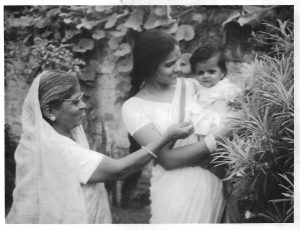
Amma with Rekha and her infant daughter (and author of this book). Although Amma lived to celebrate the birth her first grandchild, she died of a heart attack the following year, at the age of only fifty-four.
MS: It was sort of a bittersweet thing to do for me. I felt like I had no choice but to write it in her voice and it’s not just an homage to her. It really is her book. It’s her project. She talked about writing a book about her parents for as long as I remember. And she did write a number of books. She wrote a couple of scholarly books and a couple of creative books, but she never got around to working on this project and I never really understood why. Year after year, she was producing all these books—she had written nine books by the time she passed away—and she would talk all the time about “that’s the one book I need to work on,” but she never got around to doing it.
When she was quite sick and we knew the end was near, I had made her a promise. I said “when you feel stronger, we will both write this book together,” because this was one of her expressed regrets. It became a promise that I had to keep. When I started writing this as a book, I wasn’t sure what I was going to do, but then my head was filled with her voice. I felt like I was just a medium. It was hard to go through that and to be so acutely aware of her loss. It’s been almost eight years and I still feel her loss. She was my best friend. I think that emotional piece of our relationship made it both easy and very difficult to write in her voice. But not for a moment did I feel like I needed to do anything else. I had no doubt that it had to be written in her voice.
AUP: You currently live on Vancouver Island. Did you return to India while you were writing the book?
MS: Yes, I did. And, at the time that I started writing, I was living in Edmonton. It was really a very emotional experience for me to go back to India after my mother’s death. I left India in 1997, first for South Africa and then, in 2006, I moved to Edmonton. But I used to go to India every year while my parents were alive. There were times when I went to India more than once a year. I had this very complete connection with India (even though I wasn’t living there) until 2010, which is when my mother died. After that I just couldn’t bring myself to go to India. My father had died in 2005, so my mother was my last parent and it felt like her loss was not just a loss of a parent but also the loss of a home.
I just couldn’t go back until I started writing the book and collecting material and I realized I needed to do the archival research. I needed to interview people in person. I had my sabbatical planned for 2013 and so I spent about two months in India and a few weeks in London to do the archival research.
AUP: So we’ve talked a little bit about the challenges of writing in your mothers’ voice. Were there any parts of Amma’s story that were particularly difficult to write?
MS: The difficulty was connected to her emotional state of being, I would say, with respect to what she was going through. I have access to her personal diary which was written over a period of time. She started writing it in August 1926, so she would have been about 8 years old. There’s no chronological order to the entries in the diary. For the first part of the diary, the entries are quite consistent as if she is trying to write every day and then it starts to space out quite a bit and you have entries from 1942 followed by entries from 1962 and 1950 followed by 1938.
A lot of her diary is very cryptic. She protects people’s identities. For example, she uses people’s names when it’s something positive, but when it’s an unflattering image or an uncomfortable or awkward event, she just alludes to things and talks about her owns struggle with it. What helped me to decipher this was the oral history that I inherited from both my mother and my aunt and from all these regular visitors to the family home. In some cases, there are dates and a description of her state of mind so I have tried to connect dots and piece things together. For me, that was a very difficult thing to do because I feel like it was a historical project and I have been very careful and meticulous to make sure everything is historically authenticated. But there were those pieces where I wasn’t really sure—I felt like I didn’t have enough supporting material but I had enough to say this is what it may have been like. So those are some of the personal pieces, the emotional pieces that I found really tough to write about and particularly the ones that were connected to the family of her birth, which she chose to not talk about or give us many clues about her life before 1926.
AUP: Has writing Amma’s story and learning about her role as a revolutionary affected the way you live your life?
MS: Absolutely. I think I inherited some of her political sensibilities because I grew up in her shadow and I was always trying to figure out the bigger picture and think about institutions and structures. As a social scientist and as a political economist, I do a lot of that analysis very consciously to look at structures and institutions and connect them to individual lives. But what I realized while doing this work was how many blind spots I still had. One of the things that I find myself doing, not just as an individual, but also as an academic, is to constantly ask myself, “Where are the women?” That has really shifted my perspective. I thought I was a feminist but now I’m seeing the blind spots of feminism that I have also inherited. In many ways, writing this story has changed how I view privilege and how I view invisibility. But more than that, it has made me want to do something—not just acknowledge it but actually make more space for people to be able to address those inequities and injustices.
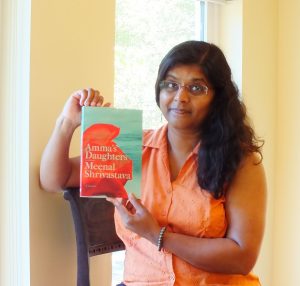
Meenal Shrivastava with her book.
AUP: You’ve written about the erasure of women in your academic work. How does this memoir complement that work? Why did you choose to write a work of creative non-fiction instead of a scholarly monograph?
MS: I wrote a journal article before this book came out which was published in a journal that deals with issues of globalization. That article was written to provide the context to the archival research that I had done for this book. But even while I was writing that article, I was working on the book. They were simultaneously evolving as I was collecting material, collating the information, and interpreting all the data that I had acquired and I could see the limits of just doing an academic piece.
Academic publishing often has massive paywalls that prevent your work from being read widely so it gets contained within echo chambers—you are always singing to the choir and I felt that that environment would not do justice to this story. If this story is about highlighting the role of women and the nature and scale of women’s involvement in any major social or political movement or moment, then an academic journal article is not going to make a dent. This kind of narrative account is easily accessible in terms of being free of jargon and the academic requirements of publication. While it fulfills a number of academic requirements in terms of historical authenticity and quoting arguments and observations, at the same time it is more accessible to a general audience. The fact that it is published by Athabasca University Press, which has an open access mandate, is an additional benefit that makes it accessible to as many people as possible.
Find out more about Amma’s Daughters and browse the photo gallery at ammasdaughters.com.
